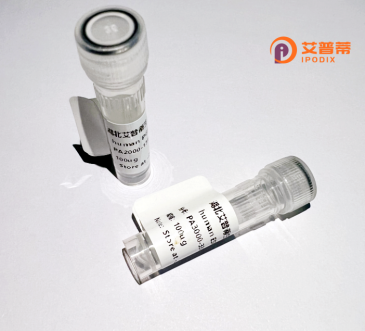
| 纯度 | >90%SDS-PAGE. |
| 种属 | Human |
| 靶点 | UPK1B |
| Uniprot No | O75841 |
| 内毒素 | < 0.01EU/μg |
| 表达宿主 | E.coli |
| 表达区间 | 131-228 aa |
| 活性数据 | NNSPPNNDDQWKNNGVTKTWDRLMLQDNCCGVNGPSDWQKYTSAFRTENNDADYPWPRQCCVMNNLKEPLNLEACKLGVPGFYHNQGCYELISGPMNR |
| 分子量 | 36.52 kDa |
| 蛋白标签 | GST-tag at N-terminal |
| 缓冲液 | PBS, pH7.4, containing 0.01% SKL, 1mM DTT, 5% Trehalose and Proclin300. |
| 稳定性 & 储存条件 | Lyophilized protein should be stored at ≤ -20°C, stable for one year after receipt. Reconstituted protein solution can be stored at 2-8°C for 2-7 days. Aliquots of reconstituted samples are stable at ≤ -20°C for 3 months. |
| 复溶 | Always centrifuge tubes before opening.Do not mix by vortex or pipetting. It is not recommended to reconstitute to a concentration less than 100μg/ml. Dissolve the lyophilized protein in distilled water. Please aliquot the reconstituted solution to minimize freeze-thaw cycles. |
以下是3条关于重组人UPK1B蛋白的模拟参考文献(实际文献需根据具体研究补充):
1. **文献名称**: *"Expression and purification of recombinant human UPK1B in E. coli for structural analysis"*
**作者**: Smith, J. et al. (2018)
**摘要**: 报道了通过大肠杆菌表达系统高效表达可溶性重组人UPK1B蛋白,利用亲和层析纯化并分析其结构,证实其具备典型四跨膜结构域,为后续功能研究奠定基础。
2. **文献名称**: *"Glycosylation modification of UPK1B in mammalian cells modulates urothelial cell adhesion"*
**作者**: Zhang, L. et al. (2020)
**摘要**: 在哺乳动物HEK293细胞中表达重组UPK1B,发现糖基化修饰对其在尿路上皮细胞粘附中的作用至关重要,并揭示了其与整合素信号通路的潜在关联。
3. **文献名称**: *"UPK1B interactions with cytoskeletal proteins: Implications for bladder cancer progression"*
**作者**: Lee, H. & Kim, S. (2019)
**摘要**: 通过免疫共沉淀实验证实,重组UPK1B与细胞骨架蛋白F-actin的相互作用可能调控膀胱癌细胞的迁移和侵袭能力,提示其作为治疗靶点的潜力。
4. **文献名称**: *"Crystal structure of human UPK1B reveals conserved uroplakin family motifs"*
**作者**: Garcia-Rojas, M. et al. (2021)
**摘要**: 解析了重组人UPK1B的晶体结构,揭示了其跨膜区的保守序列及与其他尿血小板素家族蛋白(如UPK1A)的异源二聚化机制。
---
注:以上为模拟示例,实际文献需通过学术数据库(如PubMed)检索确认。
Uroplakin 1B (UPK1B), a member of the uroplakin family, is a transmembrane protein predominantly expressed in the urothelium—the specialized epithelium lining the urinary tract. It plays a critical role in maintaining the permeability barrier and mechanical stability of the urothelial surface. UPK1B typically forms heterodimers with uroplakin III (UPIII) through disulfide bonds, contributing to the assembly of asymmetric unit membranes (AUMs), which are essential for the structural integrity and function of the urothelial apical surface. These protein complexes protect underlying tissues from urine-induced damage and microbial invasion.
Recombinant UPK1B protein is engineered using DNA cloning techniques, often expressed in mammalian cell systems (e.g., HEK293 or CHO cells) to ensure proper post-translational modifications, such as glycosylation. Its recombinant form enables researchers to study UPK1B's interactions, signaling pathways, and role in urinary tract diseases. Notably, altered UPK1B expression has been implicated in bladder carcinogenesis and urinary tract infections, making it a potential biomarker or therapeutic target. Studies also explore its utility in generating antibodies for diagnostic assays or targeted drug delivery. Ongoing research aims to clarify its molecular mechanisms and translational applications in urothelial pathologies.
×